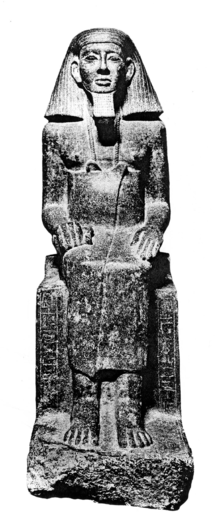Ankhu
| Ankhu Vizier | |
|---|---|
 Stela of Amenyseneb, mentioning Ankhu in the text | |
| Dynasty | 13th Dynasty |
| Pharaoh | Khendjer, Sobekhotep II and others |
| Father | possibly Zamonth |
| Children | Resseneb, Iyteru |
Ankhu was an Egyptian vizier who lived in the 13th Dynasty around 1750 BC.
Biography
Ankhu is known from several monuments dating to the reigns of the 13th Dynasty kings Khendjer and Sobekhotep II, attesting that he served several kings. Ankhu appears in the Papyrus Boulaq 18 as the head of the court officials. The papyrus is dated to the reign of Sobekhotep II and mentions Queen Aya.[1] The queen's image appears also on a stela which shows that she was part of Ankhu's family. A stela found at Abydos dated to the reign of Khendjer reports on building works at the Osiris temple. In the Amun temple at Karnak he erected statues of himself, his father[2] and his mother. The latter is one of the very few statues belonging to a woman placed in this temple.[3]

Ankhu was the son of a vizier. Labib Habachi proposed that his father was the vizier Zamonth. The mother of Ankhu is known as Henutpu, the name of Zamonth'e wife is published as Henut. Habachi wonders whether Henut is a mistake or short version of Henutpu. The name Henut is otherwise not attested.[4] Detlef Franke bascially agreed with this identification and calculates that Ankhu must have been 50 to 60 years old under king Khendjer.[5]
Ankhu was the father of two further viziers: Resseneb and Iymeru. The family formed a strong dynasty of high court officials.
Ankhu ruled at least under two, perhaps even under five, kings of the 13th Dynasty. His situation illustrates that during this period the viziers were the real power behind weak kings. The kings were only in power for a short period, while the viziers remained in power for longer periods.[6][7]
Ankhu was married to a woman called Mereret. One of the daughters of the couple was called Senebhenas. She was married to the overseer of the half domain Wepwawethotep. The latter was related to queen Aya, albeit it remains uncertain in which way. Both appear together on the above mentioned stela.
References
- ↑ Wolfram Grajetzki: Court Officials of the Egyptian Middle Kingdom, London 2009 p. 38 ISBN 978-0-7156-3745-6
- ↑ Cairo, Egyptian Museum CG 42034 (JE 36646).
- ↑ Grajetzki: Court Officials of the Egyptian Middle Kingdom, p. 39, fig. 18
- ↑ Labib Habachi: The Family of the Vizier Ibia in: Studien zur altägyptischen Kultur 11 (1984), p. 123
- ↑ Detlef Franke: Personendaten aus dem Mittleren Reioch (20.-16. Jahrhundert v. Chr. Dossiers 1-796, Ägyptologischen Abhandlungen 41, Wiesbaden 1984, ISBN 3-447-02484-4, p. 137
- ↑ W. C. Hayes: A Papyrus of the late Middle Kingdom in the Brooklyn Museum, New York 1955, p. 146-47
- ↑ Rice, Michael: Who's Who in Ancient Egypt. Routledge, 1999, pp. 24-25.
| Wikimedia Commons has media related to Ankhu. |
Further reading
- K.S.B. Ryholt, The Political Situation in Egypt during the Second Intermediate Period (Carsten Niebuhr Institute Publications, vol. 20. Copenhagen: Museum Tusculanum Press, 1997), p. 243-45